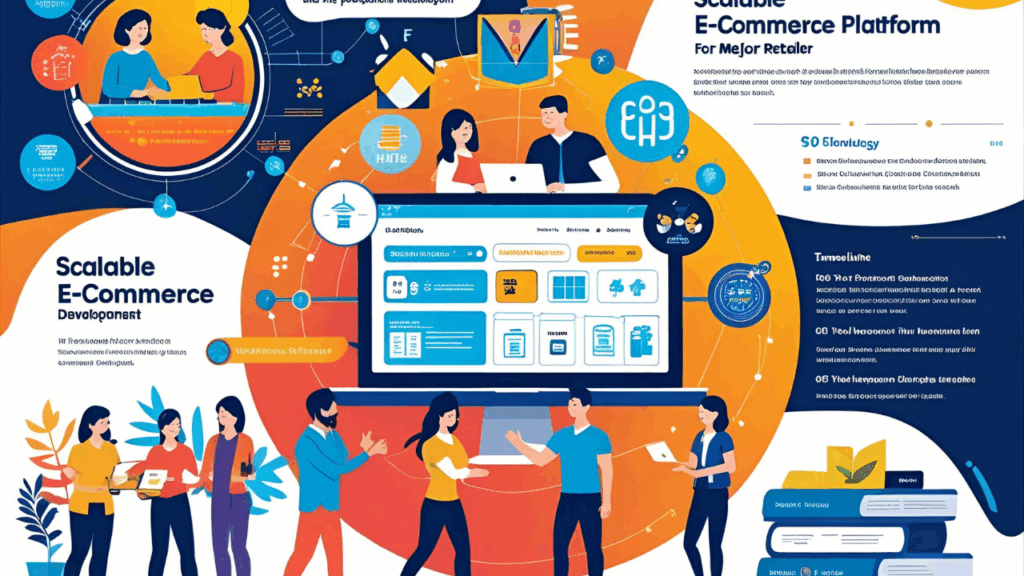When our partner—a national retail powerhouse—faced a 300% surge in online traffic over two years, their legacy monolithic platform simply couldn’t keep up. Flash sales crashed the site. Black Friday turned into downtime nightmares. Mobile checkout slowed to seconds. Customer frustration translates into lost revenue—up to 70% cart abandonment on poor performance. We knew: uptime, speed (<200 ms), and seamless mobile experience weren’t nice-to-haves—they were business-critical.
🚀 Introduction: Why Scalability Was Non-Negotiable
Our mission: Design a platform capable of:
- Handling 10 million daily users
- Processing 5,000 tx/s during peak
- Managing 200,000+ SKUs
- Achieving 99.99% uptime, 200 ms page loads, zero cart failures
To achieve this, we crafted a cloud-native, API-first, microservices-first solution optimized for scale and availability.
📈 The Business Imperative: Data-Driven Stakes
- Traffic growth: +300% website visits in 18 months
- Downtime cost: Even 10 minutes of outages = hundreds of thousands in lost revenue
- Cart abandonment: 50–70% during peak — due to slow page loads
- Strategic response: Need for rapid feature delivery, global scale, and seamless user experience
Takeaway: Performance failure isn’t a tech problem—it’s a revenue problem.
🧭 Architecture Principles & Design Choices
✅ Key Non‑Functional Requirements (NFRs)
- Scalability – horizontal across regions
- Availability – target 99.99% SLA
- Performance – sub‑200 ms P95 load time
- Modularity – fast independent deployments
- Security – PCI‑compliant checkout
- Cost-efficiency – utilize cloud elasticity
🛠️ Microservices: Why and How
Monoliths scale poorly; microservices isolate failures, allow selective scaling, and enable parallel teams. In e-commerce, scale matters most during flash sales and global events (Daffodil Insights, Hygraph, Medium).
☁️ Cloud-First, Kubernetes-Driven
We chose AWS with multi-AZ VPCs, EKS (Kubernetes), Terraform for Iac, supported by spot autoscaling. Stateless services made horizontal scaling efficient.

🧩 Core Tech Stack & System Components
| Layer | Technology & Role |
|---|---|
| API Gateway | Kong + NGINX for routing, auth, rate limiting |
| Authentication | OAuth2/JWT via Keycloak (SAML for enterprise B2B) |
| Product Catalog | Gopher-based services + PostgreSQL with Redis caching |
| Search | Elasticsearch, 5-node + replicas |
| Cart & Checkout | Node.js services, Redis-backed sessions |
| Orders | Java/Spring Boot + Kafka for event streaming |
| Payments | PCI compliant via Stripe/Adyen |
| Inventory Sync | CDC via Debezium + Kafka Connect |
| Front-end | React + Next.js (SSR, dynamic imports) + headless CMS |
| CDN | AWS CloudFront, image optimization, custom TTL |
| Monitoring | Prometheus + Grafana, AWS X‑Ray |
| Observability | OpenTelemetry, eBPF for kernel‑level tracing (Daffodil Insights, Wikipedia) |
📦 Microservices Deep Dive
🔍 Product Catalog
Built in Go, exposed via REST/GRPC, backed by PostgreSQL with master‑replica replication and Redis for high-query throughput. Indexed in Elasticsearch for fast search.
Result: 300ms reduction in response times under load.
🔄 Cart & Checkout
Node.js stateless services using Redis for sessions. Kubernetes Horizontal Pod Autoscaler scaled only the Cart/Checkout layer during spikes, reducing cost.
💳 Payment Handling
Token-based credit card handling offloaded to Stripe/Adyen. We implemented robust webhook retry and idempotency patterns.
📦 Inventory Synchronization
Inventory data from ERP synced via Debezium/Kafka Connect, streamed to services through Kafka topics. Consumers update local caches and availability features in near real-time.
🔧 Deployment, Orchestration & CI/CD
- Containerization: Docker + Kubernetes (EKS).
- CI/CD: GitHub Actions pipeline — Build → Test → Stage → Canary → Prod.
- Terraform: Manages infra including VPCs, K8s clusters, monitoring, DBs.
- Observability: Prometheus, EBS, X-Ray, OpenTelemetry, eBPF for tracing .
🌐 Global Footprint & CDN Strategy
Using CloudFront for static assets, Route 53 routing per-region, multi-AZ RDS. SSR via Next.js deployed to AWS Lambda@Edge. Added fallback SSR for outages.
🧪 Testing & Performance Tuning
- Load Testing: K6 + JMeter on real traffic patterns.
- Chaos Engineering: Simulated pod failures, network loss.
- Database Scaling: Sharding + read-replicas to sustain >10K QPS.
📈 Measured Outcomes
- 99.992% uptime post-launch
- Average page load <180 ms under 500K concurrent users
- Cart abandonment dropped 45%, boosting conversions
- Deployment frequency x4, time-to-market halved
- Cloud cost optimized by 30% via spot instances
🛡️ Lessons Learned & Best Practices
- Start with NFR clarity – performance, scalability as first-class requirements
- Domain-model first – define microservices domains early
- API contracts matter – strict versioning, backward compatibility
- Use event-driven design – Kafka/CDC for loose coupling
- Invest in observability – trace down performance bottlenecks
- Chaos builds confidence – failure injection validates robustness
- Scale granularly – autoscale the right services
- CSPM & Security audits – ensure PCI compliance, manage secrets
These align with industry best-practices on cloud-native, microservice e-commerce (Wikipedia, BetterCommerce, Medium).
🧠 Governance, Team & Culture Impact
- Platform team: managed shared Kubernetes platform and tools
- Service teams: autonomous squads owns features & deployments
- DevOps integrated: SRE functions embedded per team
- Stand-ups & docs: API-first with automated documentation generation
🏁 Conclusion
Scaling an e-commerce giant requires more than infrastructure—it demands architecture built around microservices, cloud elasticity, event-driven design, and relentless monitoring. Our platform delivered reliability, performance, and growth agility—transforming business outcomes during peak retail events.
FAQs,
🔧 Technical Architecture & Scalability
1. What does “scalable e‑commerce platform” mean?
It refers to a system designed to handle increasing workloads—more users, products, or traffic—without downtime or performance degradation (StoreHippo, Wikipedia).
2. Monolithic or microservices—what’s better for scalability?
Microservices are usually preferred. They allow independent scaling of components (like catalog, cart, payments) and reduce blast radius during failures .
3. How important is cloud infrastructure?
Very. Cloud platforms offer elastic scaling, global reach, and cost-control by adjusting compute resources dynamically .
4. Why use event-driven architecture?
Event-driven systems (e.g. Kafka, Debezium) enhance resilience and real-time capabilities by decoupling services—perfect for order processing, inventory updates, notifications (metamindz.co.uk).
🏗️ Infrastructure & Design Questions
5. What core components does a scalable architecture need?
Key layers include:
- API Gateway (e.g., Kong, NGINX)
- Authentication (OAuth2/JWT)
- Product Catalog (Postgres + Redis)
- Search (Elasticsearch)
- Cart/Order/Payment services
- CDN for static assets
- Observability tools (Prometheus, tracing)
See our detailed architecture section above.
6. How do databases scale effectively?
Use horizontal scaling via sharding and replication for high-throughput workloads; vertical scaling for smaller setups. Techniques like row-level locks and partitioning optimize performance (Ranosys, metamindz.co.uk).
7. How to ensure high availability (99.99% uptime)?
Adopt multi-AZ (availability zone) deployment, auto-scaling groups, container orchestration (e.g. Kubernetes), and thorough observability (monitoring + alerting).
📊 Performance & Testing
8. How do you maintain sub-200 ms response under peak load?
- Use caching (Redis, CDN)
- Scale critical services horizontally
- Profile and optimize hot paths
- Conduct load testing (JMeter, k6) and chaos engineering to stress-test the system.
9. What data to monitor?
Track metrics like latency (P95/P99), error rates, CPU/memory usage, request volume, database lag, and service dependencies. Use Prometheus + Grafana.
🌍 Globalization & Edge Delivery
10. How do we serve content globally?
Use CDNs (e.g., CloudFront) and deploy SSR (server-side rendering) containers closer to users (Edge), ensuring fast content delivery and resilience.
💳 Checkout & Payments
11. How to handle secure payments at scale?
Outsource to PCI-compliant providers like Stripe or Adyen. Implement webhooks, idempotent operations, and retries to ensure reliability.
12. How to prevent duplicate orders?
Use idempotency keys and order-source tracking. Employ transactional or event-store mechanisms to guarantee “exactly once” handling.
📱 Mobile & UX
13. Is mobile-first design essential?
Yes—modern commerce is predominantly mobile. Prioritize fast, responsive front-end, use lazy loading, and support mobile wallet payments (Apple/Google Pay) (TechRadar).
📈 Business & Ops
14. What’s the difference between growing and scaling?
- Growth raises volume and costs proportionally.
- Scaling increases revenue capacity while keeping cost growth minimal through automation and efficiency (TechRadar, Sana Commerce).
15. When should we scale?
Signs include recurring demand spikes, high cart abandonment, and constrained systems—especially when retention and acquisition metrics justify scaling (salesforce.com).
16. How to choose between custom and off-the-shelf platforms?
Base your decision on budget, flexibility needs, and technical maturity. Platforms like Shopify or BigCommerce scale fast with less technical investment; custom builds give you full control over architecture (jurysoft.com).
🔐 Security & Compliance
17. How do we stay PCI compliant at scale?
Outsource payment handling, ensure regular security scans, manage secrets carefully, monitor for vulnerabilities, and apply SOC 2/PCI audits.
18. What about logical security in SOA environments?
Implement strong service authentication, message validation, encryption, and centralized security controls across your service mesh or API gateway.
✅ Summary
A scalable e-commerce platform requires:
- Microservices + event-driven architecture
- Elastic cloud deployment & CDNs
- Automated CI/CD pipelines and testing
- Granular observability
- Clear scaling vs. growth mindset
- Secure and mobile-first design
These FAQs align with industry practices (e.g., Shopify, OroCommerce, Virtocommerce) and will elevate the value of your blog both for readers and search ranking. Let me know if you’d like to include more specialized topics—like PCI compliance, SSR strategy, or specific cloud vendor comparisons!






